Ramayana places in sri lanka
The epic tale of Ramayana, one of the most revered and celebrated ancient Hindu scriptures, has left an indelible mark on the cultural and religious heritage of Sri Lanka. The island nation is dotted with numerous places associated with the Ramayana, each holding a unique significance in the story. Embark on a spiritual journey as we explore some of the prominent Ramayana places in Sri Lanka
20 Ramayana Sites in Sri Lanka
- Munneswaram Temple
- Manavari Temple
- Ram Setu Bridge
- Thiru Koneswaram Temple
- Kanniya Hot Springs
- Sita Kotuwa
- Dunuwilla
- Dolukanda Sanjeewani Mountain
- Yahangala
- Chariot Path
- Gayathri Peedam
- Hanuman Temple in Ramboda
- Ashok Vatika
- Sita Amman Temple
- Divurumpola
- Ravana Fall
- Ravana Cave
- Ussangoda
- Rumassala
- Kelaniya Raja maha viharaya
Sri Lanka map of the Ramayana related places in Sri Lanka

Ramayana, an ancient Hindu epic attributed to the sage Valmiki, narrates the life and adventures of Lord Rama, his wife Sita, and his loyal devotee Hanuman. Sri Lanka, known as Lanka in the Ramayana, plays a crucial role in the story, serving as the kingdom of Ravana, the antagonist of the epic. Many locations in Sri Lanka have become pilgrimage sites due to their association with the Ramayana.
Ramayana Story in Short
The Ramayana unfolds with the banishment of Lord Rama from Ayodhya, his rightful kingdom, due to a conniving plot by his stepmother Kaikeyi. Accompanied by his wife Sita and brother Lakshmana, Rama embarks on a fourteen-year exile to the forests. This phase of the epic highlights Rama’s humility, adaptability, and his deep bond with his companions.
During their exile, Sita is abducted by Ravana, the powerful demon king of Lanka. The narrative intensifies as Rama and Lakshmana search for Sita relentlessly. The episode showcases Sita’s steadfastness and her unwavering faith in her husband’s rescue mission. It also introduces the pivotal character of Hanuman, who becomes an ardent devotee of Rama and a crucial ally in the epic’s progression.
Hanuman’s journey to Lanka forms a significant chapter in the Ramayana. He crosses the ocean in search of Sita, displaying extraordinary feats of strength and agility. He encounters various challenges and ultimately succeeds in finding Sita in the Ashoka Grove, providing her with hope and assurance. Hanuman’s exploits showcase loyalty, determination, and unwavering devotion.
The Ramayana reaches its climax with the great battle between Rama and Ravana. The conflict represents the eternal struggle between good and evil, righteousness and arrogance. Rama, aided by an army of divine monkeys, fights valiantly against Ravana’s formidable forces. The battle is filled with fierce encounters, epic duels, and strategic maneuvers. Ultimately, Rama’s divine prowess prevails, and Ravana meets his righteous end.
1. Munneswaram Temple
Munneswaram Temple, also known as the Muneswaram Kovil, is a prominent Hindu temple situated in Chilaw, a coastal town in Sri Lanka. This ancient temple holds immense historical and religious importance, serving as a revered place of worship for devotees of Lord Shiva. Legend has it that the temple was established by Lord Rama, the revered hero of the epic Ramayana, during his quest to seek blessings for victory against the demon king Ravana. Since then, the temple has been a place of pilgrimage and devotion for Hindus, attracting devotees seeking blessings and spiritual solace. The Maha Shivaratri festival at Munneswaram Temple is a major celebration dedicated to Lord Shiva, attracting devotees from far and wide to partake in the festivities and seek blessings.

2. Manavari Temple
Dating back several centuries, Manavari Temple is believed to be one of the oldest temples in the region. It holds immense religious significance as it is considered to be the first temple built by Lord Rama during his quest to free his wife Sita from the clutches of the demon king Ravana. This temple stands as a symbol of Lord Rama’s devotion and his gratitude towards Lord Shiva.It is believed to be the place where Lord Rama installed a Lingam to seek blessings and atone for the sins committed during the war with Ravana. The temple’s serene surroundings and sacred atmosphere make it a significant pilgrimage site for devotees.

3. Ram Setu Bridge
The Ram Setu Bridge, also known as Adam’s Bridge or Rama’s Bridge, is a mystical structure that connects the Indian subcontinent to the island of Sri Lanka. The Bridge is located in North Province of Sri Lanka Close to Jaffna. Steeped in mythology and cultural significance, this bridge has captivated the imagination of people for centuries. As per the ancient scriptures, the construction of Ram Setu took place under the supervision of Lord Rama’s loyal devotee, Hanuman. The army of Vanaras (monkeys) and bears worked tirelessly to build the bridge by carrying rocks, trees, and boulders and placing them in the sea.
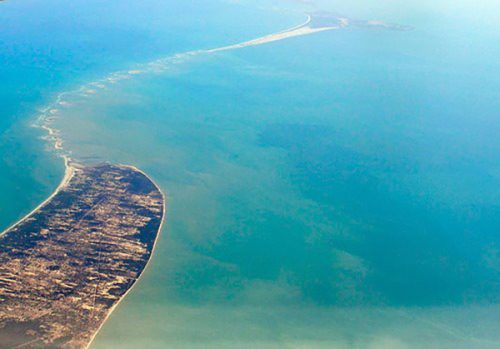
4. Kanniya Hot Springs
The Kanniya Hot Springs, located near Trincomalee, is a collection of seven natural hot water springs. These springs are believed to have healing properties. The springs mentioned in the Ramayana as a place where Lord Rama and his army refreshed themselves during their quest to rescue Sita. And also there is an another Legend says that these springs originated from the tears shed by Ravana during a fierce battle with Lord Rama. Visitors can immerse themselves in the therapeutic waters and experience a sense of rejuvenation.

5. Thiru Koneswaram Temple
Thiru Koneswaram Temple, also known as the Temple of the Thousand Pillars, is a majestic Hindu temple situated in Trincomalee. The origins of Thiru Koneswaram Temple can be traced back to ancient times. According to legends, the temple was built by Lord Rama, the hero of the epic Ramayana, during his quest to rescue his wife, Sita. The temple’s name, “Koneswaram,” is derived from the Tamil word “Kone,” which means “king” or “kingdom.” The main shrine, dedicated to Lord Shiva, stands tall and majestic, with its intricate detailing and exquisite craftsmanship leaving visitors in awe. Koneswaram Temple is one of the must visit Ramayana Place in Sri Lanka.

6. Dunuwilla
Situated near the 40 km post on the Hasalaka – Wasgamuwa road, Dunuwila occupies a vital place among the notable sites of the Ramayana tour in Sri Lanka. Dunuwila holds a significant place as the site where Lord Rama unleashed the powerful Brahmaastharam, ultimately leading to the demise of King Ravana. The name “Dunuwila” itself carries profound meaning, with “Dunu” symbolizing an arrow and “Vila” representing a lake. It was here, at the shores of this very lake, that Lord Rama launched his decisive arrow. Today, Dunuwila stands as one of the most renowned Ramayana Sites in Sri Lanka, captivating visitors with its historical and cultural significance.
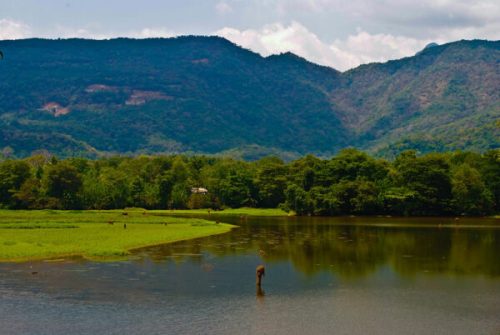
7. Dolukanda Sanjeewani Mountain
Dolukanda Sanjeewani Mountain, also known as Dolukanda, is a prominent geographical landmark located in Sri Lanka. It is situated in the North Central Province, near the town of Kurunegala. According to local legends, it is believed to be the place where Lord Hanuman landed while searching for the herb “Sanjeevani” to cure Lord Rama’s brother, Lakshmana. At the summit, visitors can find a temple dedicated to Lord Hanuman, attracting devotees and tourists alike. The temple is adorned with colorful sculptures and paintings depicting scenes from the Ramayana. It serves as a place of worship and a pilgrimage site for those seeking blessings and spiritual solace.
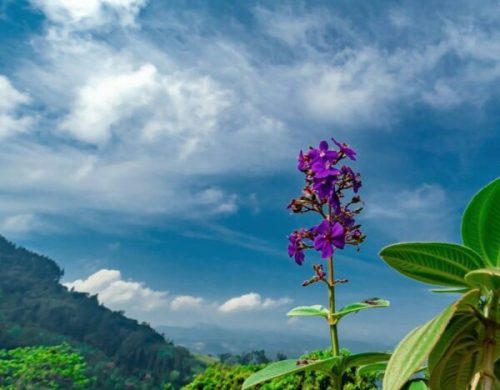
8. Yahangala
Yahangala, also known as Bed Rock Mountain is located in eastern edge of the Knuckles Mountain Range. According to the folks and legends, Yahangala is believed to be the site where great King Ravana is sleeping until he awakens. The serene surroundings and panoramic views make it a favorite spot for nature lovers and spiritual seekers and Reaching Yahangala requires careful planning and consideration.
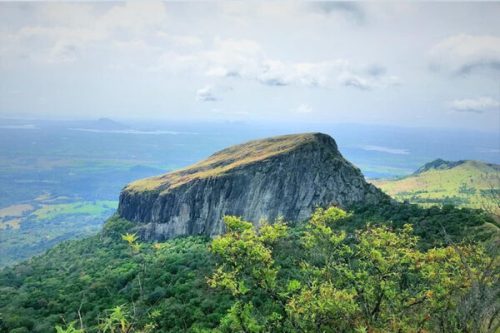
9. Sita Kotuwa
Sita Kotuwa is a historical site located at Gurulupotha, Hasalaka in Central Province of Sri Lanka. It is believed to be the place where Sita was held captive by the demon king Ravana. According to the Ramayana, It is said that Ravana had a magnificent palace in the city of Lankapura, where Sita was kept captive. Sita Kotuwa is believed to be the remnants of this ancient city. It is a small area surrounded by dense forests and is considered a significant site for Hindu devotees.
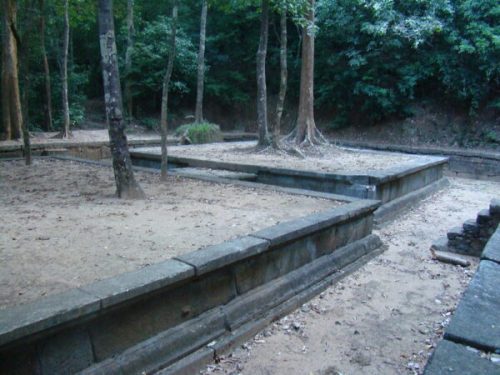
10. Hanuman Temple in Ramboda
The Hanuman Temple in Ramboda, Close to Nuwara Eliya, is dedicated to Lord Hanuman, the monkey god and Lord Rama’s trusted ally. According to the Ramayana, Hanuman played a pivotal role in locating Sita and conveying Lord Rama’s message to her. The temple stands at the spot where Hanuman is believed to have rested during his search for Sita. Devotees flock to this temple to seek Hanuman’s blessings and witness the awe-inspiring statue of the deity.

11. Chariot Path
The Chariot Path, also known as “Ravana’s Chariot Track,” is a mystical site located in Situated in the picturesque village of Sita Eliya, nestled amidst lush greenery and breathtaking landscapes. According to ancient legends, this path was believed to be the route taken by King Ravana. Legend has it that King Ravana used the Chariot Path to transport the captured princess Sita from his capital, Lanka, to his kingdom in the central highlands. This journey marked a pivotal moment in the Ramayana, a tale of love, devotion, and adventure. The Chariot Path is said to bear the imprints of Ravana’s chariot wheels, forever etched into the rocky terrain.

12. Gayathri Peedam
Gayathri Peedam, located in Nuwara Eliya, is a sacred shrine dedicated to the goddess Gayathri, the embodiment of divine energy. It is believed that Gayathri, in the form of a fiery figure, provided spiritual enlightenment to Lord Rama during his battle against Ravana. The shrine’s tranquil ambiance and natural beauty attract devotees who seek blessings and inner harmony.
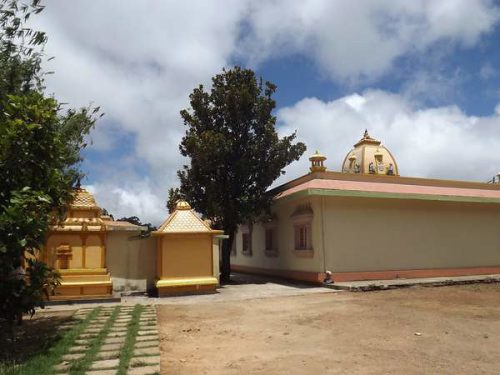
13. Ashok Vatika
Ashoka Vatika is steeped in mythical legends and tales from the Ramayana. It is believed that this garden was created by Lord Indra, the king of gods, to provide solace and comfort to Sita during her captivity. The garden was adorned with beautiful flowers, lush greenery, and majestic trees, offering respite to Sita amidst her trials and tribulations. Also it is believed to be the spot where Sita, separated from Lord Rama, awaited her rescue. The garden witnessed the meetings between Sita and Hanuman, the brave monkey god who played a crucial role in the rescue mission. The story of their encounters and the devotion of Hanuman adds to the significance of Ashoka Vatika.
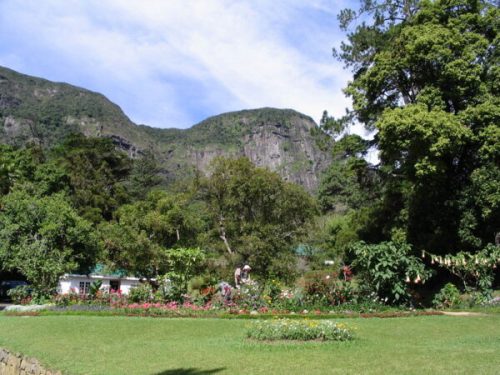
14. Sita Amman Temple
The Sita Amman Temple is an ancient and revered religious site located in the town of Nuwara Eliya. According to ancient legends, Princess Sita, the beloved consort of Lord Rama, sought refuge in this very place during her captivity. The Sita Amman Temple stands as a testament to her resilience, purity, and unwavering devotion. It is said that the temple was built at the exact spot where Sita once resided, offering a connection to her extraordinary journey.

15. Divurumpola
Divurumpola, meaning “a place of oath,” holds a significant place in the Ramayana epic. According to legend, it was at this very location that Sita, the consort of Lord Rama, proved her purity and faithfulness through the Agni Pariksha (trial by fire). Divurumpola has since evolved into a sacred site that symbolizes forgiveness, justice, and liberation. The Ramayana tells the tale of Sita, who was abducted by the demon king Ravana. After her rescue by Lord Rama, doubts about her purity emerged among the people. To prove her loyalty, Sita underwent the Agni Pariksha, where she stepped into a pyre of fire. Miraculously, the fire did not harm her, and she emerged unscathed, validating her purity and devotion.
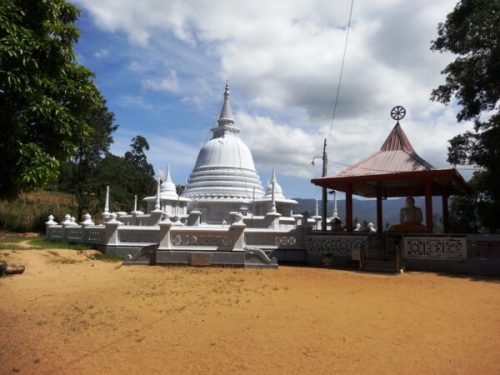
16. Ravana Fall
Ravana Falls, also known as Ravana Ella, is a breathtaking waterfall located in the beautiful island country of Sri Lanka. This majestic natural wonder is nestled amidst the lush greenery of the Uva Province, near the town of Ella. The falls derive their name from the mythical King Ravana, who ruled Sri Lanka during ancient times. It is said that King Ravana had a magnificent pleasure garden near this waterfall, where he brought the captive princess Sita after abducting her.As visitors approach Ravana Falls, they are greeted by a stunning cascade of water plunging from a height of approximately 82 feet (25 meters). The waterfall is characterized by multiple tiers, creating a captivating visual display as the water gracefully descends.

17. Ravana Cave
Nestled amidst lush green landscapes, Ravana Cave stands as a remarkable testament to the intersection of myth and history. It is believed that Ravana used this cave as a sanctuary during his reign. Legends tell tales of Ravana’s deep meditation within the cave, where he sought spiritual enlightenment and conducted ritual and also the king used this cave to hide the Princess Sita. The 1370-meter-high Ravana Cave is situated 2 kilometers outside of Ella town. With about 650 uneven steps, the path leading up to the Ravana Cave is steep and difficult. In some locations, there are only steep rocks and broken or missing steps.
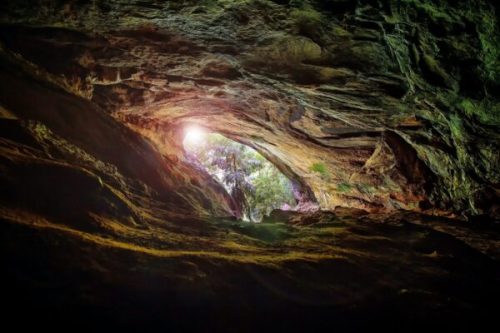
18. Ussangoda
Ussangoda served as a significant location during the era of Ramayana. It is said that King Ravana, a pivotal character in this ancient epic, utilized the flat and solid terrain of Ussangoda as a landing ground for his celestial vehicle, the Pushpak Vimana. A striking feature of Ussangoda is its distinctive red sand, an anomaly that has piqued the curiosity of both locals and visitors. Folklore suggests that this unusual hue can be attributed to an extraordinary event involving the mighty Hanuman, the revered monkey deity. Legend has it that Hanuman, in a valiant act, set ablaze the land of Ussangoda, leaving an indelible mark on its soil. The intense heat from the fire is believed to have transformed the color of the sand, infusing it with a rich reddish tint that endures to this day.
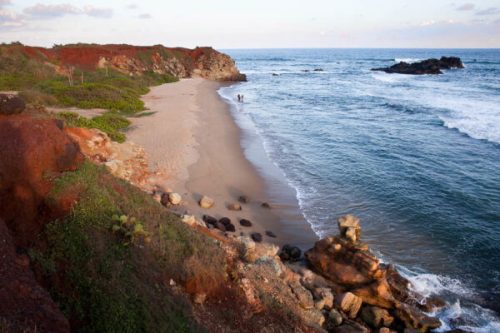
19. Rumassala
Rumassala is a place located in Sri Lanka, specifically in the southern coastal city of Galle. The mountain is also known as “Ramasalu” or “Sanjeewani Parvatha” in local folklore and has a rich cultural heritage. According to the legend, Hanuman, the monkey god, brought a chunk of the Himalayas to Sri Lanka in order to heal the wounded warriors of Lord Rama’s army. However, some pieces of the mountain fell along the way, and one of them is believed to be Rumassala.

20. Kelaniya Raja Maha Viharaya
According to the epic, after the passing of King Ravana, Lakshmana, the loyal brother of Lord Rama, crowned Vibhishana as the new ruler in Kelaniya. This transpired because Lord Rama, bound by his promise to his father, King Dasarath of Ayodhya, had to return to India to fulfill his 14-year self-exile. Consequently, Lakshmana played a pivotal role in ensuring the smooth transition of power by crowning Vibhishana. This extraordinary tale further solidifies the Kelaniya Buddhist Temple’s status as an integral destination on the sacred Ramayana tour in Sri Lanka.
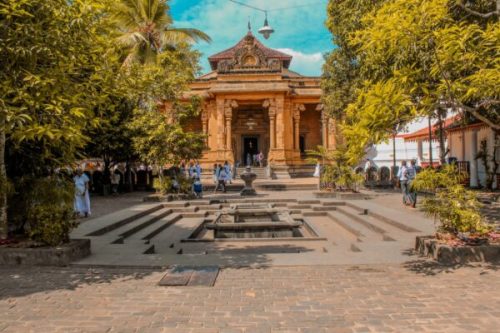
The Ramayana sites in Sri Lanka offer a fascinating glimpse into the mythical world of Lord Rama, Sita, and their extraordinary journey. These sites not only hold religious and historical significance but also showcase the natural beauty and cultural heritage of Sri Lanka. Visiting these sacred places allows devotees and enthusiasts to connect with the rich tapestry of the Ramayana and immerse themselves in the timeless tale of love, devotion, and righteousness.
FAQs
1. How many Ramayana Places in Sri Lanka
There are more than 50 Ramayana Sites in Sri Lanka those has been identified from the legend
2. Are the Ramayana sites in Sri Lanka accessible to tourists?
Yes, most of the Ramayana sites in Sri Lanka are open to tourists and can be visited throughout the year.
3. Are there any entry fees for visiting these sites?
Some sites may have nominal entry fees while others may not charge any fees for entry.
4. Are there any guided tours available for visiting these places?
Yes, guided tours are available for visitors who prefer a comprehensive and informative experience. Local tour operators can provide details and arrange guided tours. If you Interested in visiting Ramayana Sites you can always contact Ceylon Hunt or visit our Ramayana tours.
5. Is it necessary to have prior knowledge of the Ramayana to visit these sites?
Prior knowledge of the Ramayana is not essential. most of the the sites are often accompanied by informative signage or guided tours that provide the necessary context and background.
Image courtesy of Mahesh, Dhammika Heenpella, Sandeep Singh, da5idgpk, Sarala Jeevanthi Gamage, Mora Hiking Club, Lahiru Rajasekara, Off 2 Sri Lanka, Zeloan Travel, Chamara Samaraweera, sri_sanjeewa_bc, manu prasad, mayakaiyan via creative commons licenses. some rights reserved.
We hope you enjoyed this blog on 20 Must visit Ramayana Sites in Sri Lanka!
If you have any questions, please send us a message on our website or leave a comment below so that we can respond!






